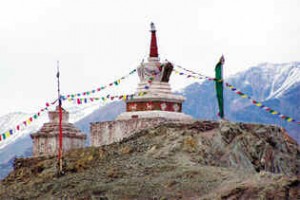Jigmet Palmo
Chortens in Ladakh are usually accompanied by the Mani walls or ‘mane thang’ and the colorful flags or ‘tarchok’ that flutters round the clock thus bringing life to the deafening silence. When put together, these symbolic  references of religion tend to represent purity of thought and prayerful obeisance carrying the prayers of the faithful on the wings of horse wind traditionally called ‘lungsta’. It embodies wish fulfillment and makes one’s soul compassionate that’s why the Buddhists of Ladakh seem to have erected numerous Chortens in their surrounding generously and voluntarily. Chorten is a visual document of Buddhist architecture, to house Buddhist relic or ‘ringsrel’ to support worship.
references of religion tend to represent purity of thought and prayerful obeisance carrying the prayers of the faithful on the wings of horse wind traditionally called ‘lungsta’. It embodies wish fulfillment and makes one’s soul compassionate that’s why the Buddhists of Ladakh seem to have erected numerous Chortens in their surrounding generously and voluntarily. Chorten is a visual document of Buddhist architecture, to house Buddhist relic or ‘ringsrel’ to support worship.
Introduction of Buddhism in Ladakh is attributed to the King Asoka. However a major boost to Buddhist religion was granted by Kanishaka. It is said that he convened the fourth Buddhist council in Kundalvana Vihara and Sani Stupa in Zanskar is also attributed to Kanisha.
Sociological studies of human history have indicated that since time immemorial there exists in human groups or the communions a sociological phenomenon that gives rise to belief, faith, ritual, and practices. In Buddhist culture one of such practices prevalent in Ladakh is the construction of Chorten.
Ladakh often called “the land of lama”, is a part of Jammu And Kashmir State and has due to its remoreness attained a special position in preserving cultural and religious heritage. The great scholar lama Rinchen bZang-po is often credited with construction of 108 Chorten and monasteries in this particular Himalayan region. One of the oldest Chorten is in Sani Zanskar built by the king Kanishka.
One of the most important facts is the development of stupa since from prehistoric times. In ancient times a small and simple mound (tumulus) on the ground was the best representation to preserve the relic which slowly and gradually emerged in a composite classical mighty structure for instance that of Sanchi Stupa in Madhya pradesh.
Chorten are built to symbolize Buddha and the five elements of nature -: Earth, Water, Fire, Air and Ether, which is the medium that body converts to after death.
The architecture of a Chorten symbolically represents Buddha’s body as under:
a) The square base represents the element earth and the Buddha’s throne b) The four steps above the base represent the crossed- leg of Buddha. The mound represents the element of water and also Buddha’s torso c) Above the mound, the Chyan, represents the Buddha’s eye. d) The spire represents the Buddha’s crown and element of fire.
e) On top of the spire is a crescent that represents air. F) An oval circle on the crescent represents the element ether- the realm of spirit.
There are eight types of Chortens representing the eight events in the Buddha’s life. These are Padspun Chorten (birth), Changchup Chorten (enlightenment), Choskor Chorten (Turning of wheel), Chotul Chorten (Miracle), Lhabab chorten (Descent from a heavenly realm), Endum chorten (Reconciliation of Sangha), Namgyal chorten (victory) and mYandas chorten (Parinirvana).
Another integral part of chorten complex are Mane-walls. These long walls are made of stone carved with mantras and their main purpose is to ask the gods to look after travelers and to protect settlements
The name of the walls is derived from the mantra Om Mane Padme Hum which is inscribed on every stone and rock that makes up the structure. These walls are often located in an isolated path like that of Hemis, Stok, Nimmo along with Leh.
It is also believed that mane wall is a necklace and each stone is jewel which expresses thanksgiving. One of the mane walls below the kiu-tag in Leh was built in memory of queen Zilzom’s deceased husband.
The materials used in a Chorten include brick, stone, timber, limestone, silver, gold or brass. In the present times, portable Chortens along with recorded mantra of Om mane Padme Hum also being made.
Ladakhis believe that the construction of a Chorten brings good luck, happiness, prosperity, health and wealth. A large numbers of Chorten are found lavishly decorated along the side of houses. Travelers and visitors rest under the shade of Chortens.
Another type of oldest Chorten, is that of Tisseru and found in the mule shape rock which is believed to be the evil of all natural phenomena.
For the Ladakhis, one of few living Buddhist societies, a Stupa or Chorten, is a living presence, that existing along the sides of roads, backyards, open spaces, ensures good luck, happiness, prosperity, health and wealth and above all a general sense of well being.
(The author is a student of Art History and Aesthetic Deapartment (IMFA) Jammu)

